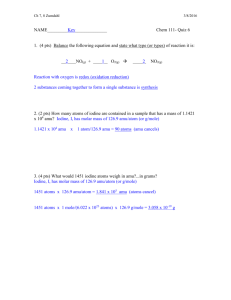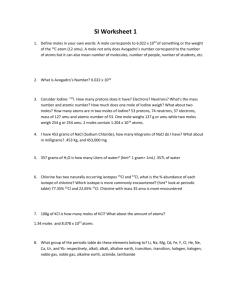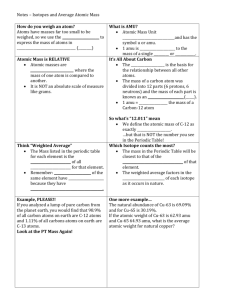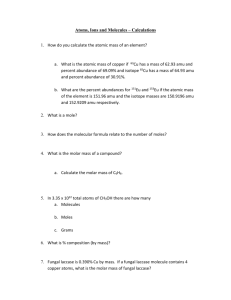ch 4 - sierackihonorchem
advertisement
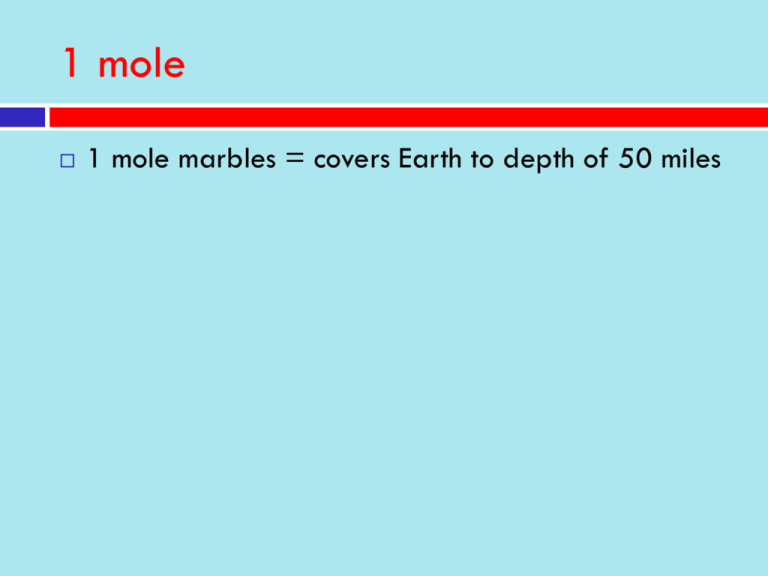
1 mole 1 mole marbles = covers Earth to depth of 50 miles Counting by weighing Purpose: Calculate the amount of pennies in the bag by weighing them. ( You may take the pennies out of the bag to weigh them, but do not count them) Data Calculations Atoms are too small to count so we weigh an amount (mole) and calculate the number Avogodro The actual size of the molecule is not important Avagadro concluded that equal volumes of gas have equal number of molecules By the way, nobody really knew what a molecule was at the time Some words mean numbers Pair Dozen Baker’s dozen Gross Ream Mole 1 mole = 6.02 x 1023 representative particles (atoms) (molecules) (formula units) ( the number of carbon-12 atoms in 12.00 g) Atomic mass units We measure atoms in atomic mass units Atomic mass unit = AMU = 1.66x10-27 Kg It is defined as 12 for Carbon – 12 Carbon 12 has six protons and six neutrons 1 proton=1 amu (1.0078amu) 1 neutron= 1 amu (1.0087 amu) Chemical Measurements Atomic Mass The weighted average of all the mass numbers for all the isotopes of the atom (a.m.u.) Formula Mass The sum of all the atomic masses for all atoms in the compound. (a.m.u.) Calculate the atomic mass or formula masses Na Cl Br2 NaCl CO2 Mg(OH)2 22.99 amu 35.45 amu 159.80 amu 58.45 amu 44.01 amu 58.33 amu Molar Mass = = = The mass of 1 mole ( 6.02 x 1023) of representative particles The atomic mass in g The formula mass in g Atom, Molecule and Ions Representative particles – smallest particle of that substance Substance Representative Particle element molcular compound ionic compound atom molecule formula unit Calculate the Molar mass Ca H2 KNO3 (NH4)2S Remember 1 mole 1 mole = 6.02 x 1023 r.p. = molar mass(g) practice 1. 2. Determine the number of FU in .866 moles of AgNO3? Find the mass of 0.98 moles of CaCl2. Molar Volume The volume of 1mole of a gas at standard temperature – 0oC standard pressure – 1 atmosphere (pressure at sea level) 1 mole gas at STP = 22.4 L Remember 1 mole 1 mole 1 mole = 6.02 x 1023 r.p. = molar mass(g) = 22.4 L gas Multistep problems How many fu in 18.9 g NaCl? How many L in 4.5 x 1013 molecules Ne? Solution= solute + solvent • • • % mass = g solute g of solution PPM = parts of solute 1,000,000 parts of solution Molarity = Moles solute L of solution Calculate 1. What is the molarity if 13.5 g NaCl in 451 ml solution? 2. How many g of KOH are in 3.5 L of a .67 M solution? 3. How many ml of solution would you need to have 17.5 g of NaOH in a .35 M solution? Percent Composition % element = g element x 100% g total compound Formulas Empirical simplest whole number ratio Molecular Formula actual number of atoms in the formula Practice: A compound has 13.5 g Ca 10.8 g O .675 g H What is its empirical formula? Try this one What is the empirical formula that is 25.9% N , 74.1% O Spark 1. How many moles of HCl are there in 1.00 liters of 2.0 molar HCl? 2. How many milliliters of 13.2 g of HCL of a 3.4 M solution? 3. How many oxygen atoms are in 150.2 mL of 2.00 M H2SO4? 4. How many sulfur atoms are in 158.2 g of aluminum thiosulfate , Al2 (S2O3)3? Molecular formula Set up table: Empircal formula Molar mass Molecuar A Chemical Reaction Balance the following reaction Hydrogen and oxygen react to produce water H2 + O 2 H 2 O 2H2 + O2 2H2O Why Do We Balance an Equation / Reaction? Makes it look pretty I do what I’m told Has something to do with conservation Of mass Gas Has Mass The balanced equation says I should mix two hydrogens with one oxygen And then the reaction should go well Let’s See! So if……. If the space between molecules is so large and volume of gas at equal pressure and equal temperature have the same number of molecules •How can we compare things that are not gases? Mass We would weigh it. Of course. But reactions go by numbers of molecules and atoms Not by mass, which is in grams I wonder if there is a conversion factor? How Can We Measure Atoms, the Darn Things are Too Small? We can compare the mass of atoms This was done back in the 1800’s Hydrogen was found to be the smallest element Everything was “relative” to Hydrogen So we can compare elements by using hydrogen as a standard Consider This About Atoms Each atom of hydrogen has 1.0 amu and uranium has 238 amu. Which has more atoms, one gram of H or one gram of U? Calcium has 40. amu per atom and helium has 4 amu per atom. Approximately how many times more atoms are in one gram of helium than in one gram of calcium? Wow So if we can compare masses of atoms to each other Then we could weigh them to get the proper proportion of them in a reaction Wouldn’t that be convenient? If only there were a conversion factor!
